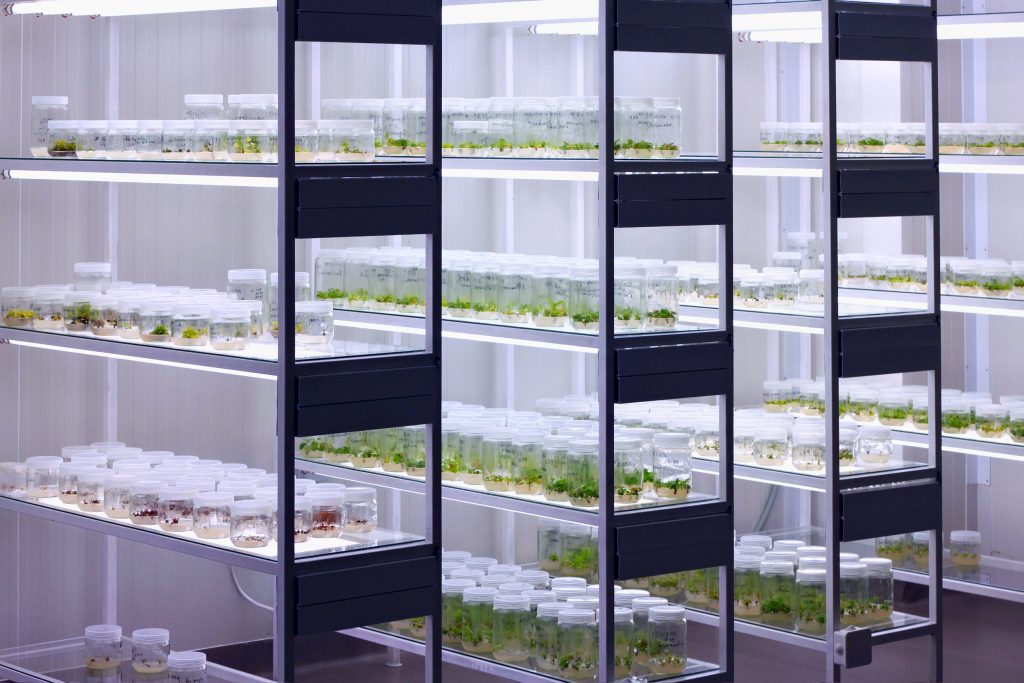
Tissue culture, specifically through the method of micropropagation, stands as a beacon of innovation in the field of cannabis cultivation. This technique, rooted in the principles of plant science, allows for the precise and controlled growth of cannabis plants from cells, tissues, or organs, all within a sterile environment that mitigates the risks of contamination and disease. The process of micropropagation is particularly valuable in the cannabis industry, where the demand for uniformity, potency, and safety in plant products cannot be overstated. By utilizing this method, cultivators can bypass many of the challenges associated with traditional propagation techniques, such as variability in plant quality, susceptibility to diseases, and the limitations of physical space.
Meristem culture, a subset of tissue culture, further enhances the potential of micropropagation by targeting the very heart of plant growth—the meristematic tissue. This tissue, responsible for the plant’s primary growth, is comprised of undifferentiated cells capable of rapid division and differentiation into various plant organs. By isolating and cultivating these meristematic tissues, growers can produce cannabis plants that are not only free from pathogens but also genetically identical to their parent plant, ensuring a consistent product with predictable effects and quality. This method is especially crucial for preserving the genetic purity and characteristics of high-value cannabis strains, offering a sustainable solution to the challenges of scalability and genetic preservation. As such, tissue culture and meristem culture represent transformative approaches to cannabis cultivation, promising a future where efficiency, consistency, and quality are the hallmarks of cannabis production.
The Foundation of Plant Tissue Culture
the evolution of tissue culture reflects a remarkable journey from conceptual theory to widespread application across various fields of plant science. Gottlieb Haberlandt’s visionary experiments in 1902, aiming to grow plant cells in an artificial medium, laid the groundwork for what would become a cornerstone of modern botany and agriculture. Although his initial attempts were not entirely successful, they sparked a century of research and innovation. By the mid-20th century, advancements in understanding plant hormones, nutrient media, and sterile techniques enabled tissue culture to transition from a laboratory curiosity to a practical tool for mass propagation, genetic research, and conservation efforts.
In the context of cannabis, the transition towards tissue culture techniques marks a significant milestone in the plant’s commercial and medicinal development. As legal barriers began to fall in the late 20th and early 21st centuries, the burgeoning cannabis industry faced the challenge of producing consistent, high-quality plants on a scale never before seen. Tissue culture, with its ability to produce genetically uniform and disease-free plants, offered an ideal solution. This shift not only reflects the adaptability and innovation inherent in agricultural practices but also highlights the unique demands of cannabis cultivation, including the need for standardization and quality control in a rapidly evolving market. The adoption of tissue culture in cannabis cultivation thus represents not just a technical advancement but a broader shift towards more scientific, controlled, and efficient agricultural practices, setting a new standard for the industry’s future.
Advantages of Tissue Culture in Cannabis Cultivation

Tissue culture transforms cannabis cultivation by offering:
- Disease Eradication: Initiating cultures from disease-free tissues ensures the propagation of healthy plants.
- Rapid Multiplication: A small sample can yield thousands of clones in a short timeframe, enhancing production efficiency.
- Genetic Preservation: Tissue culture methods, especially meristem culture, facilitate the conservation of desirable cannabis strains.
- Space Efficiency: Requires significantly less space compared to traditional cultivation methods, aligning with sustainable agriculture practices.
Meristem Tissue Culture: A Closer Look
Meristem tissue culture specifically targets the meristematic tissues of plants, where active cell division occurs. This technique is invaluable in cannabis cultivation for several reasons:
- Disease Elimination: Meristematic regions are typically free from viruses, making them ideal for starting disease-free cultures.
- Genetic Stability: Meristem culture ensures the genetic fidelity of the propagated plants, maintaining the unique traits of the parent strain.
- Efficiency: It allows for the rapid production of a large number of clones, essential for meeting commercial production demands.
Tissue Culture vs. Meristem Tissue Culture
General Tissue Culture encompasses a broad range of techniques involving the cultivation of plant tissues, including leaves, stems, roots, or even individual cells, on a nutrient medium under sterile conditions. This method is versatile, allowing for the propagation of a wide variety of plant species and the potential for genetic modification. It’s widely used for research, breeding, and the mass production of plants, ensuring uniformity and health of the propagated specimens.
Meristem Tissue Culture, on the other hand, is a specialized form of tissue culture that focuses on the growth of meristematic tissues — the parts of the plant where active growth occurs, such as the shoot tips and root tips. These tissues are responsible for the plant’s primary growth and are characterized by their undifferentiated cells, which have the potential to develop into any plant tissue. Meristem culture is particularly valued for its ability to produce virus-free plants. Since the meristematic regions are often free from pathogens that might infect other parts of the plant, starting cultures from these tissues can lead to the development of healthy, disease-resistant clones.
The primary difference between the two lies in their specificity and application. General tissue culture can be applied to various parts of the plant for multiple purposes, including the study of plant development, the production of secondary metabolites, and the propagation of plants. Meristem tissue culture, however, is specifically targeted at producing pathogen-free plants and preserving the genetic purity of specific strains or cultivars. This specificity makes meristem culture particularly valuable in the cannabis industry, where maintaining the genetic integrity and health of plants is paramount.
In summary, while both tissue culture and meristem tissue culture serve as vital tools in modern horticulture and agriculture, their distinction lies in their application scope and objectives. Meristem tissue culture’s focus on utilizing meristematic tissues for propagation offers a strategic advantage in cannabis cultivation, emphasizing the production of clean, genetically stable plants. This precision, coupled with the broad capabilities of general tissue culture, underscores the dynamic potential of biotechnological applications in agriculture, particularly in industries requiring high standards of purity and consistency like cannabis.
Challenges and Future Prospects
The challenges facing tissue culture in cannabis cultivation, while significant, are not insurmountable. High initial setup and operational costs, which stem from the need for specialized equipment and sterile environments, have historically limited its accessibility primarily to well-funded laboratories and large-scale operations. Similarly, the technical complexities of maintaining sterile conditions and ensuring the precise balance of nutrients and growth hormones require skilled technicians, adding to the operational challenges. Furthermore, somaclonal variation, a phenomenon where cultured plants exhibit genetic differences from their parent plants, poses a risk to the uniformity and stability sought through this method. However, the landscape is rapidly changing due to innovations in biotechnology and a growing understanding of plant cellular processes. These advancements are leading to more cost-effective and user-friendly tissue culture setups, making it feasible for a wider range of growers to adopt this method.
Moreover, the integration of tissue culture and its specialized techniques like meristem culture into the cannabis sector is a testament to the industry’s commitment to embracing cutting-edge science for better outcomes. This approach not only addresses the immediate needs for consistency, scalability, and disease management in cannabis cultivation but also sets the stage for breakthroughs in genetic engineering and plant breeding. By leveraging tissue culture, researchers and breeders have a powerful tool for exploring genetic modifications, developing new strains with desired traits such as specific cannabinoid profiles, and improving resistance to pests and diseases. Consequently, the ongoing refinement of tissue culture techniques promises not only to enhance the sustainability and efficiency of cannabis cultivation but also to contribute significantly to the genetic diversity and therapeutic potential of cannabis, ensuring its place at the forefront of agricultural innovation.
Conclusion
The fusion of tissue culture techniques, particularly meristem tissue culture, with cannabis cultivation represents a transformative shift towards precision agriculture, a paradigm where every aspect of plant growth is meticulously controlled to optimize quality and output. This synthesis of age-old gardening wisdom with the forefront of biotechnological innovation not only addresses the immediate challenges of standardization and disease management in the cannabis sector but also opens a gateway to unprecedented advancements in plant science. By harnessing the power of meristem culture, cultivators are able to propagate plants that maintain the genetic integrity and desired traits of their progenitors, ensuring that each generation meets the high standards expected by both consumers and regulatory bodies.
Furthermore, this approach significantly contributes to the sustainability of cannabis cultivation by reducing waste, minimizing the use of pesticides, and conserving genetic resources. In an industry facing scrutiny for its environmental impact, the ability to produce more with less—less space, fewer chemicals, and reduced water usage—marks a critical step forward. Additionally, the capacity of tissue culture to safeguard and expand the genetic diversity of cannabis not only enriches the available strains for cultivation but also provides a vital reservoir for research into new medical and therapeutic applications. As the cannabis industry evolves, the integration of tissue culture techniques will likely play a central role in its growth, driving innovation and ensuring that the cultivation practices of tomorrow are safer, more efficient, and more sustainable than ever before, truly heralding a new era in the science of cannabis cultivation.
How useful was this post?
Click on a star to rate it!
Average rating / 5. Vote count:
No votes so far! Be the first to rate this post.
Author
-
Thom Thatsanaphon is a figure in the cannabis cultivation industry with a rich background spanning over 24 years. His journey began in the legacy market, where he honed his skills and knowledge in cannabis cultivation. Throughout his career in this field, Thom has demonstrated a deep understanding and passion for the art and science of growing cannabis. In recent years, Thom took on the role of Head of Cultivation at a facility based in Illinois. This position allowed him to apply his extensive experience and insights into managing large-scale cannabis cultivation operations. His leadership in this role has been marked by an emphasis on quality, innovation, and sustainable practices, which are crucial in the highly competitive and evolving cannabis industry. Currently, Thom is channeling his expertise into the pursuit of breeding top-tier genetics. This new phase of his career focuses on developing high-quality cannabis strains with superior traits such as potency, aroma, flavor, and medicinal properties. His work in breeding is not just about creating commercially viable strains, but also about pushing the boundaries of cannabis genetics to achieve new levels of excellence. Thom's dedication to the field is not only evident in his professional achievements but also in his commitment to staying abreast of the latest trends, technologies, and scientific advancements in cannabis cultivation and genetics. His deep understanding of the plant, combined with a forward-thinking approach, positions him as a significant influencer and innovator in the cannabis industry.
View all posts






